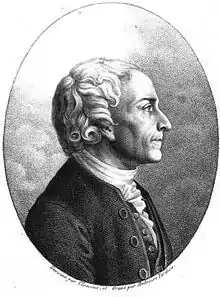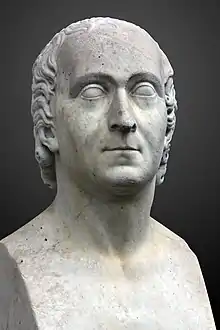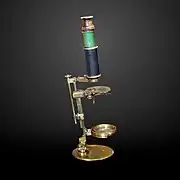Abraham Trembley | |
|---|---|
 Abraham Trembley | |
| Born | 3 September 1710 |
| Died | 12 May 1784 (aged 73) |
| Nationality | Genevan |
| Known for | hydra (genus) |
| Awards | Copley Medal, 1743 |
| Scientific career | |
| Fields | Naturalist |

Abraham Trembley (3 September 1710 – 12 May 1784 Geneva) was a Genevan naturalist. He is best known for being the first to study freshwater polyps or hydra and for being among the first to develop experimental zoology. His mastery of experimental method has led some historians of science to credit him as the "father of biology".[1]
Biography
Trembley came from an officer's family from Geneva, Republic of Geneva. He was uncle to Charles Bonnet, with whom he corresponded regularly, as well as to René-Antoine Ferchault de Réaumur (1683–1757) and Lazzaro Spallanzani (1729–1799). Trembley acted as tutor to the two children of Count Willem Bentinck van Rhoon (1704–1774), a prominent Dutch politician at the time. The boys were 3 and 6 when Trembley, during lessons in which he went fishing in the ponds outside the house, accidentally discovered the regenerative powers of the Hydra. Those lessons took place at the Count's summer residence of Sorgvliet nearby The Hague.[2] Sketches and drawings of his experiments with the children, made by Cornelis Pronk, are kept in the archives of the town of The Hague, the Netherlands.[3]
Work on hydra
While Trembley thought he had discovered a new species, Leeuwenhoek had in fact first published on hydra in a 1702–1703 volume of Philosophical Transactions of the Royal Society, describing them as a type of "animalculum". In his work Leeuwenhoek clearly described the process of budding, as well as their tentacles' contractility and the presence of cnidocyte batteries on tentacles.[4]
 Trembley's laboratory at Zorgvlied, as depicted in his 1744 book. Judging from his correspondence, though, his laboratory was in fact much more crowded with objects, such as up to 140 jars.[5]
Trembley's laboratory at Zorgvlied, as depicted in his 1744 book. Judging from his correspondence, though, his laboratory was in fact much more crowded with objects, such as up to 140 jars.[5] A hydra as depicted in Trembley's 1744 book.
A hydra as depicted in Trembley's 1744 book. The aquatic microscope made by John Cuff for Trembley, on display at Musée d'histoire des sciences de la Ville de Genève
The aquatic microscope made by John Cuff for Trembley, on display at Musée d'histoire des sciences de la Ville de Genève
Trembley's findings were published in a groundbreaking book in 1744, Mémoires pour servir à l'histoire d'un genre de polypes d'eau douce, Gebr. Verbeek, Leiden, translated into German in 1775 as Abhandlungen zur Geschichte einer Polypenart des süssen Wassers. The book includes some of the (engraved) drawings of Pronk. His discoveries led to his membership of the prestigious Royal Society in London and a correspondent member of the académie des sciences in France. He became also recipient of the Copley medal.
Some attribute Trembley as being the first to study stem cells, although he obviously did not refer to them as such. Trembley did however make note of their incredible regenerative capacity.[6]
References
- ↑ See Ratcliff, op.cit., p. 556, n. 1.
- ↑ Stott, Rebecca (2012). Darwin's Ghosts. New York: Spiegel& Grau. pp. 86–106. ISBN 978-1-4088-0908-2.
- ↑ Gajus Scheltema, "Pronk, Bentinck en Trembley: Schetsen uit achtiende-eeuws Den Haag", in "Jaarboek Geschiedkundige Vereniging Die Haghe", The Hague, 2005 (in Dutch).
- ↑ Phil.Trans.Roy.Soc., 1702–1703, vol.23, N 283, pp. 1304–1311//Part of a Letter from Mr Antony van Leeuwenhoek, F. R. S. concerning Green Weeds Growing in Water, and Some Animalcula Found about Them
- ↑ See Ratcliff, op.cit., p. 569.
- ↑ see "Lenhoff, Sylvia G. and Howard M. Lenhoff" Op. Cit.
Works

- Memoires pour servir a l'histoire d'un genre de polypes d'eau douce (in French). Paris: Laurent Durand. 1744.
Further reading
- "Hydra and the Birth of Experimental Biology, 1744: Abraham Trembley's Memoires Concerning the Polyps " Lenhoff, Sylvia G. and Howard M. Lenhoff, The Boxwood Press, Pacific Grove, CA1986 (ISBN 978-0-940168-01-5 )
- Breen, Quirinus (1 January 1956). "Baker, John R., Abraham Trembley of Geneva, Scientist and philosopher, 1710–1784". Journal of the Medical Library Association. 44 (1): 84–85. PMC 199989.
- Ratcliff, Marc J. (December 2004). "Abraham Trembley's Strategy of Generosity and the Scope of Celebrity in the Mid-Eighteenth Century" (PDF). Isis. 95 (4): 555–575. doi:10.1086/430649. PMID 16011294. S2CID 32642094. Archived from the original (PDF) on 16 March 2007. Retrieved 24 September 2006.
- Science and Its Times: Understanding the Social Significance of Scientific Discovery, entries on Abraham Trembley, as reproduced on http://www.bookrags.com/Abraham_Trembley.
- Animal, Vegetable and Mineral: Natural History books by ten authors Archived 29 September 2011 at the Wayback Machine, on-line exhibit, Sheridan Libraries, Johns Hopkins University
- Online biography, Institute and Museum of the History of Science, Florence